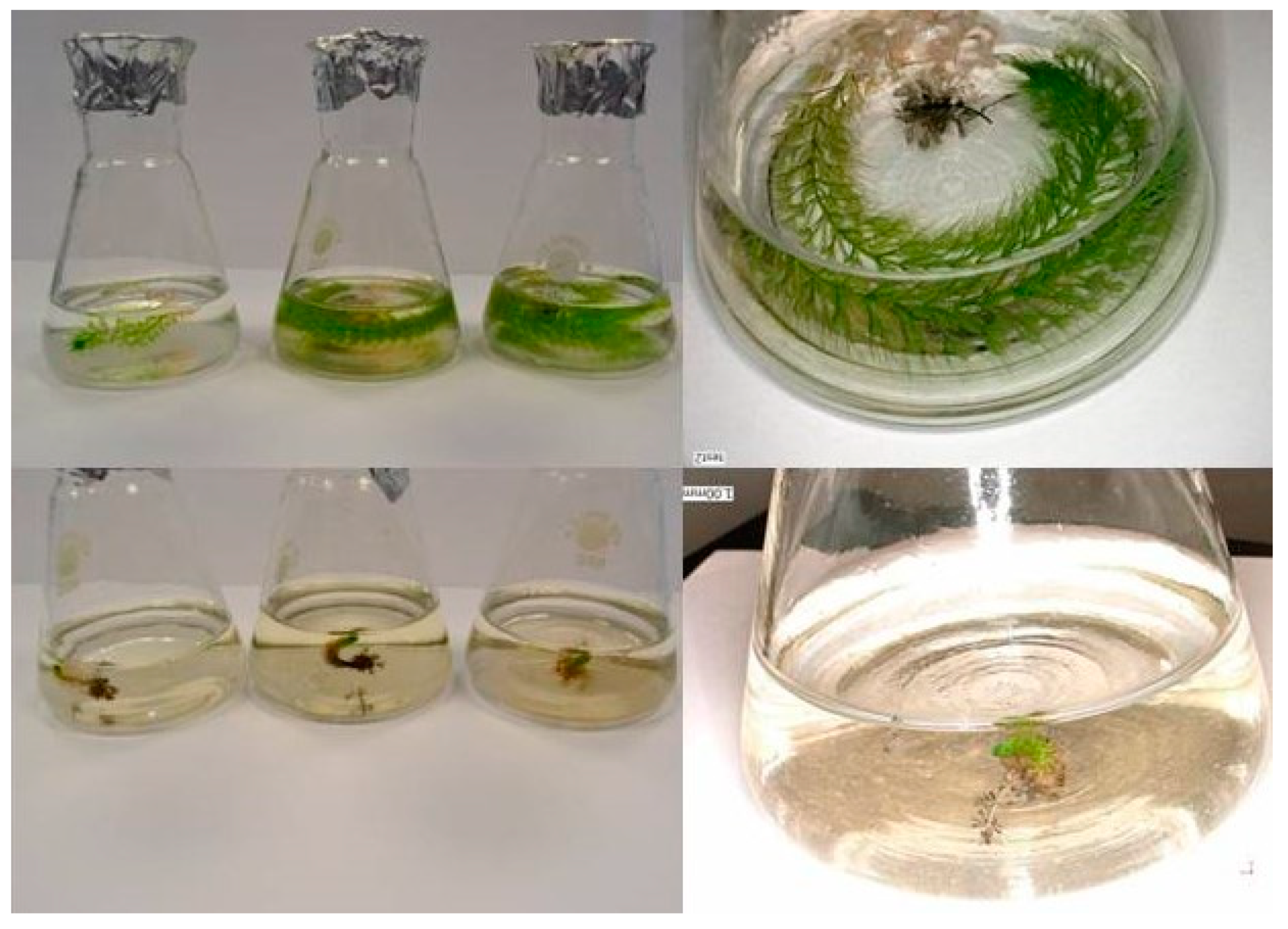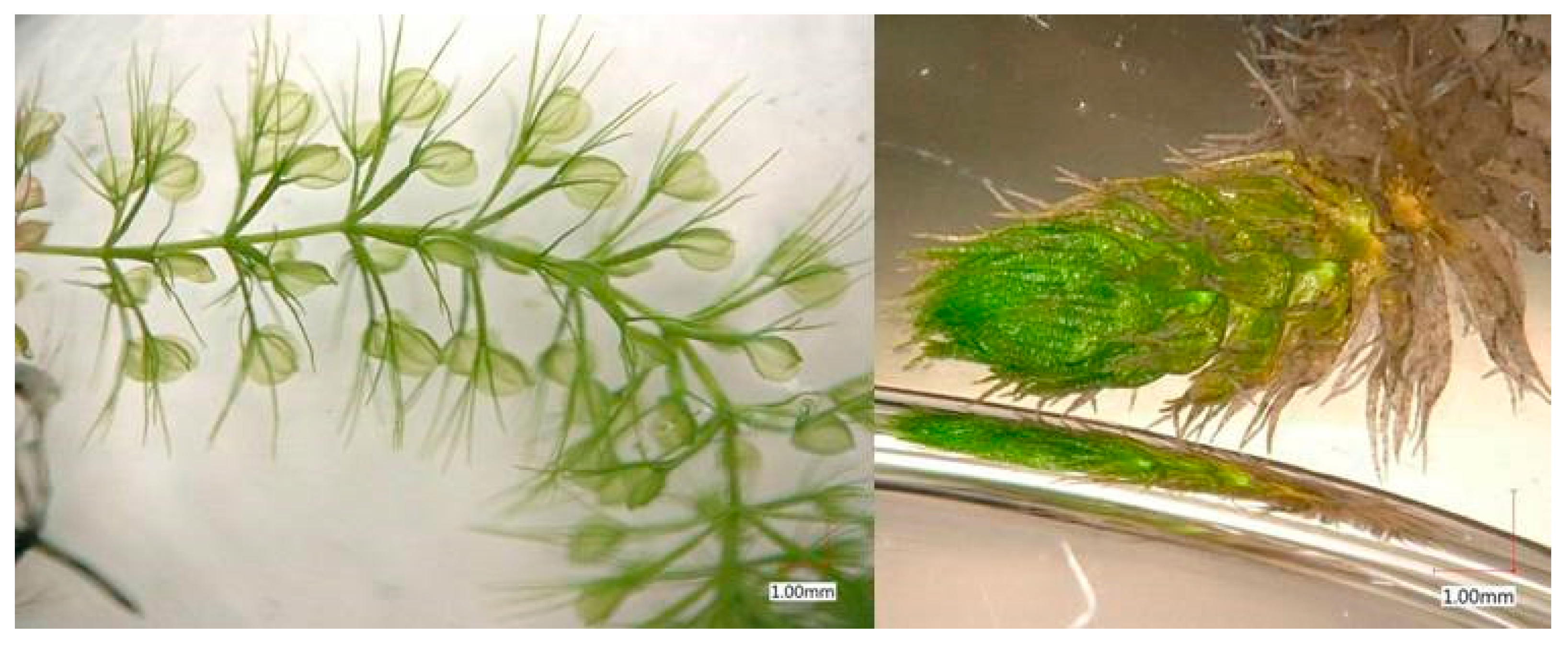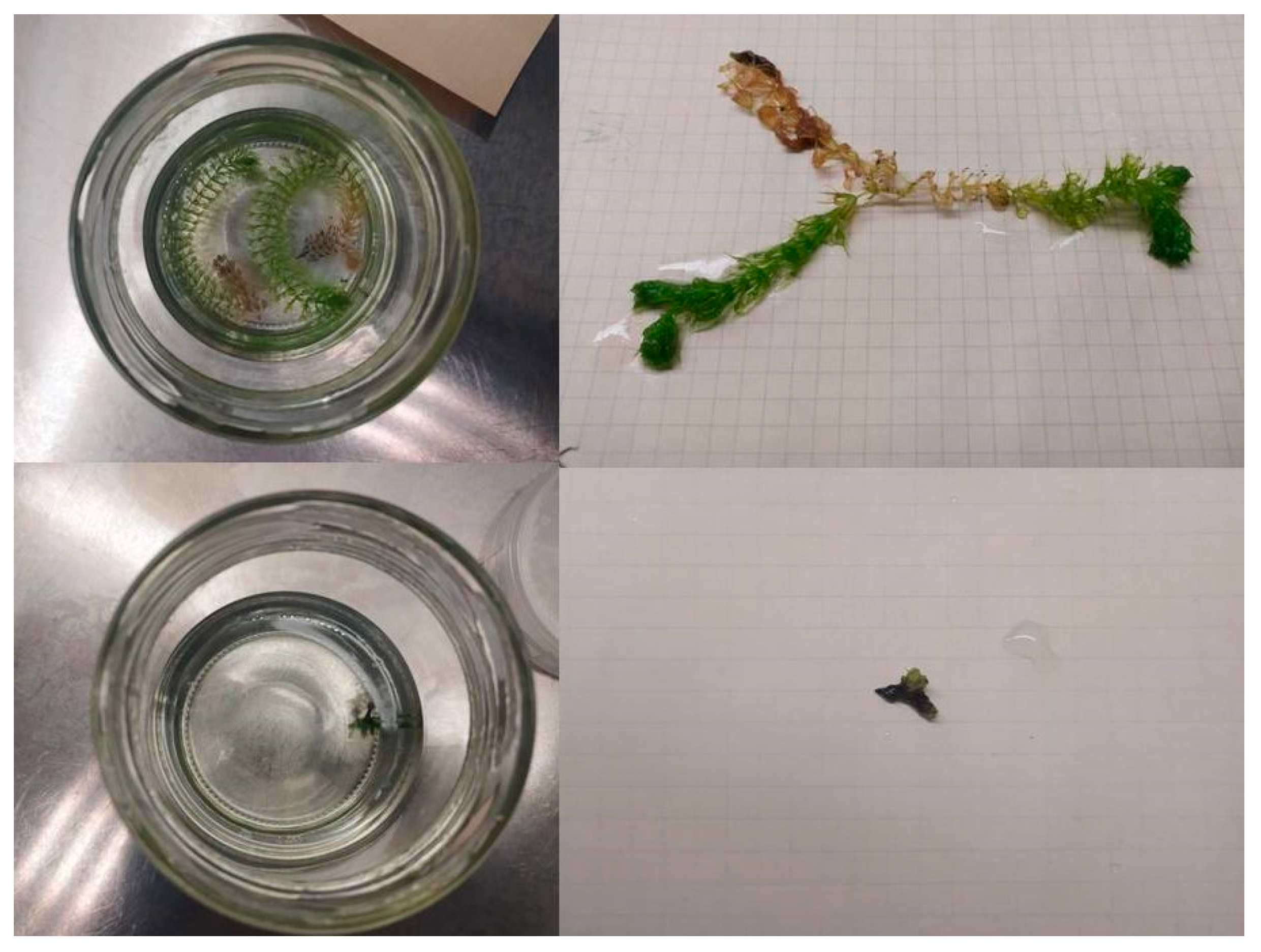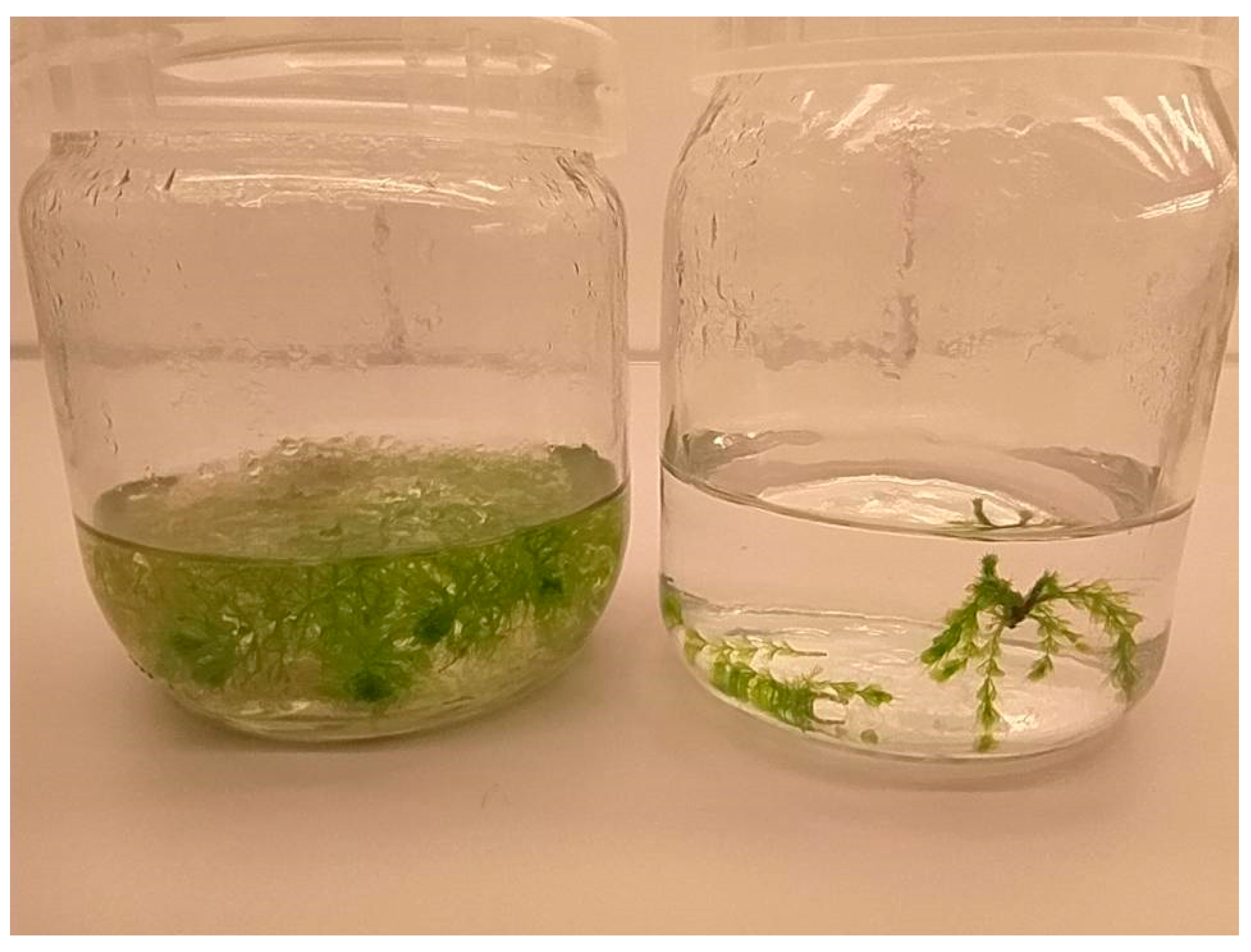Nano-Silver Particles Reduce Contaminations in Tissue Culture but Decrease Regeneration Rate and Slows Down Growth and Development of Aldrovanda vesiculosa Explants
Abstract
1. Introduction
2. Materials and Methods
3. Results
4. Discussion
5. Practical Applications and Future Research Perspectives
6. Conclusions
Funding
Institutional Review Board Statement
Informed Consent Statement
Data Availability Statement
Acknowledgments
Conflicts of Interest
References
- Kosiba, P.; Mróz, L.; Kamiński, R. Assessment of habitat conditions using self-organizing feature maps for reintroduction/introduction of Aldrovanda vesiculosa L. in Poland. Acta Soc. Bot. Pol. 2011, 80, 139–148. [Google Scholar] [CrossRef]
- Kamiński, R. Restitution of Aldrovanda vesiculosa L. in Poland and Designation of Factors Responsible for Its Surviving in Temperate Climate (Restytucja Aldrowandy Pęcherzykowatej i Rozpoznanie Czynników Decydujących o jej Przetrwaniu w Klimacie Umiarkowanym); Wydawnictwo Uniwersytetu Wrocławskiego: Wrocław, Poland, 2006; pp. 10–16, 30–37. [Google Scholar]
- Sharma, S.K.; Singh, R.; Arya, I.D. An efficient in vitro protocol for important and highly valuable medicinal plant Rauwolfia serpentina: An endangered medicinal plant of India. Vitr. Cell. Dev. Biol. Plant 2008, 44, 360–361. [Google Scholar]
- Holobiuc, I.; Blindu, R.; Cristea, V. Researches concerning in vitro conservation of the rare plant species Dianthus nardiformis Janka. Biotechnol. Biotechnol. Equip. 2009, 23 (Suppl. S1), 221–224. [Google Scholar] [CrossRef][Green Version]
- Marszał-Jagacka, J.; Kromer, K. In vitro propagation of rare and endangered serpentine fern species. In Working with Ferns; Kumar, A., Fernández, H., Revilla, M., Eds.; Springer: New York, NY, USA, 2011; pp. 149–164. [Google Scholar] [CrossRef]
- Kondo, K.; Kokubugata, G.; Varghese, S.B.; Itoyama, M.; Breckpot, C.; Kromer, K.; Kamiński, R. Conservation of Aldrovanda vesiculosa by tissue culture. Carniv. Plant Newsl. 1997, 26, 86–92. [Google Scholar]
- Adamec, L.; Pásek, K. Medium optimization for growing Aldrovanda vesiculosa in vitro. Carniv. Plant Newsl. 2000, 29, 122–124. [Google Scholar]
- Leifert, C.; Cassels, A.C. Microbial hazards in plant tissue and cell cultures. Vitr. Cell. Dev. Biol. Plant 2001, 37, 133–138. [Google Scholar] [CrossRef]
- Rai, P.K.; Kumar, V.; Lee, S.; Raza, N.; Kim, K.H.; Ok, Y.S.; Tsang, D.C. Nanoparticle-plant interaction: Implications in energy environment, and agriculture. Environ. Int. 2018, 119, 1–19. [Google Scholar] [CrossRef] [PubMed]
- Ruttkay-Nedecky, B.; Krystofowa, O.; Nejdl, L.; Adam, V. Nanoparticles based on essential metals and their phytotoxicity. J. Nanobiotechnol. 2017, 15, 33. [Google Scholar] [CrossRef] [PubMed]
- Beyth, N.; Houri-Haddad, Y.; Domb, A.; Khan, W.; Hazan, R. Alternative antimicrobial approach: Nano-antimicrobial materials. Evid. Based Compl. Altern. Med. 2015, 2015, 246012. [Google Scholar] [CrossRef] [PubMed]
- Wang, P.; Hu, C.; Shao, L. The antimicrobial activity of nanoparticles: Present situation and prospects for the future. Int. J. Nanomed. 2017, 12, 1227–1249. [Google Scholar] [CrossRef]
- Yan, A.; Chen, Z. Impacts of silver nanoparticles on plants: A focus on the phytotoxicity and underlying mechanism. Int. J. Mol. Sci. 2019, 20, 1003. [Google Scholar] [CrossRef] [PubMed]
- Jasim, B.; Thomas, R.; Mathew, J.; Radhakrishnan, E.K. Plant growth and diosgenin enhancement effect of silver nanoparticles in Fenugreek (Trigonella foenum-graecum L.). Sauid Pharm. J. 2017, 25, 443–447. [Google Scholar] [CrossRef]
- Elmer, W.H.; White, J.C. The use of metallic oxide nanoparticles to enhance growth of tomatoes and eggplants in disease infested soil or soiless medium. Environ. Sci. Nano 2016, 3, 1072–1079. [Google Scholar] [CrossRef]
- Alavi, S.; Dehpour, A. Evaluation of the nanosilver colloidal solution in comparison with the registered fungicide to control greenhouse cucumber downy mildew disease in the north of Iran. Acta Hortic. 2010, 877, 1643–1646. [Google Scholar] [CrossRef]
- Worall, E.A.; Hamid, A.; Mody, K.T.; Mitter, N.; Pappu, H.R. Nanotechnology for plant disease management. Agronomy 2018, 8, 285. [Google Scholar] [CrossRef]
- Maruyama, C.R.; Guilger, M.; Pascoli, M.; Bileshy-José, N.; Abhilash, P.C.; Fraceto, L.F.; De Lima, R. Nanoparticles based on chitosan as carriers for the combined herbicides Imazapic and Imazapyr. Sci. Rep. 2016, 6, 19768. [Google Scholar] [CrossRef] [PubMed]
- Saha, N.; Gupta, S.D. Promotion of shoot regeneration of Swertia chirata by biosynthesized silver nanoparticles and their involvement in ethylene interceptions and activation of antioxidant activity. Plant Cell Tissue Org. Cult. 2018, 134, 289–300. [Google Scholar] [CrossRef]
- Thangavelu, R.M.; Gunasekaran, D.; Jesse, M.I.; SU, M.R.; Sundarajan, D.; Krishnan, K. Nanobiotechnology approach using plant rooting hormone synthesized silver nanoparticles as “nanobullets” for the dynamic applications in horticulture—An in vitro and ex vitro study. Arab. J. Chem. 2018, 11, 48–61. [Google Scholar] [CrossRef]
- Sah, S.; Soroosh Zadeh, A.; Rezazadeh, H.; Naghdi Badi, H. Effect of nano silver and silver nitrate on seed yield of borage. J. Med. Plants Res. 2011, 5, 706–710. [Google Scholar]
- Vinković, T.; Novák, O.; Strnad, M.; Goessler, W.; Jurašin, D.D.; Paradiković, N.; Vrćek, I.V. Cytokinin response in pepper plants (Capsicum annuum L.) exposed to silver nanoparticles. Environ. Res. 2017, 156, 10–18. [Google Scholar] [CrossRef]
- Parveen, A.; Rao, S. Effect of nanosilver on seed germination and seedling growth in Pennisetum glaucum. J. Clust. Sci. 2015, 26, 693–701. [Google Scholar] [CrossRef]
- Wang, P.; Lombi, E.; Zjao, F.J.; Kopittke, P.M. Nanotechnology: A new opportunity in plant sciences. Trends Plant Sci. 2016, 21, 699–712. [Google Scholar] [CrossRef] [PubMed]
- Kim, D.H.; Gopal, J.; Sivanesan, I. Nanomaterials in plant tissue culture: The disclosed and undisclosed. RSC Adv. 2017, 7, 36492–36505. [Google Scholar] [CrossRef]
- Sarmast, M.; Salehi, H.; Khosh-Khui, M. Nano silver treatment is effective in reducing bacterial contaminations of Araucaria excelsa R. Br. var. glauca explants. Acta Biol. Hung. 2011, 62, 477–484. [Google Scholar] [CrossRef] [PubMed]
- Shokri, S.; Babaei, A.; Ahmadian, M.; Hessami, S.; Arab, M.M. The effects of different concentrations of nano-silver on elimination of bacterial contaminations and phenolic exudation of rose (Rosa hybrida L.) in vitro culture. Int. J. Farm Allied Sci. 2014, 3, 50–54. [Google Scholar] [CrossRef]
- Hedberg, J.; Skoglund, S.; Karlsson, M.-E.; Wold, S.; Odnevall Wallinder, I.; Hedberg, Y. Sequential studies of silver released from silver nanoparticles in aqueous media simulating sweat, laundry detergent solutions and surface water. Environ. Sci. Technol. 2014, 48, 7314–7322. [Google Scholar] [CrossRef]
- Künniger, T.; Gerecke, A.C.; Ulrich, A.; Huch, A.; Vonbank, R.; Heeb, M.; Wichser, A.; Haag, R.; Kunz, P.; Faller, M. Release and environmental impact of silver nanoparticles and conventional organic biocides from coated wooden facades. Environ. Pollut. 2014, 184, 464–471. [Google Scholar] [CrossRef]
- Lombi, E.; Donner, E.; Scheckel, K.G.; Sekine, R.; Lorenz, C.; Goetz, N.V.; Nowack, B. Silver speciation and release in commercial antimicrobial textiles as influenced by washing. Chemosphere 2014, 111, 352–358. [Google Scholar] [CrossRef]
- Moreno-Garrido, I.; Perez, S.; Blasco, J. Toxicity of silver and gold nanoparticles on marine microalgae. Mar. Environ. Res. 2015, 111, 60–73. [Google Scholar] [CrossRef]
- Salachna, P.; Byczyńska, A.; Zawadzińska, A.; Piechocki, R.; Mizielińska, M. Stimulatory Effect of Silver Nanoparticles on the Growth and Flowering of Potted Oriental Lilies. Agronomy 2019, 9, 610. [Google Scholar] [CrossRef]
- Saratale, R.G.; Saratale, G.D.; Shin, H.S.; Jacob, J.J.; Pugazhendhi, A.; Bhaisare, M.; Kumar, G. New insights on the green synthesis of metallic nanoparticles using plant and waste biomaterials: Current knowledge, their agricultural and environmental applications. Environ. Sci. Pollut. Res. 2018, 25, 10164–10183. [Google Scholar]
- Shanmuganathan, R.; MubarakAli, D.; Prabakar, D.; Muthukumar, H.; Thajuddin, N.; Kumar, S.S.; Pugazhendhi, A. An enhancement of antimicrobial efficacy of biogenic and ceftriaxone-conjugated silver nanoparticles: Green approach. Environ. Sci. Pollut. Res. 2018, 25, 10362–10370. [Google Scholar] [CrossRef]
- Saratale, R.G.; Saratale, G.D.; Ghodake, G.; Cho, S.-K.; Kadam, A.; Kumar, G.; Jeon, B.-H.; Pant, D.; Bhatnagar, A.; Shin, H.S. What straw extracted lignin in silver nanoparticles synthesis: Expanding its prophecy towards antineoplastic potency and hydrogen peroxide sensing ability. Int. J. Biol. Macromol. 2019, 128, 391–400. [Google Scholar] [CrossRef] [PubMed]
- Murashige, T.; Skoog, F. A revised medium for rapid growth and bio assays with tobacco tissue cultures. Physiol. Plant. 1962, 15, 473–497. [Google Scholar] [CrossRef]
- Abdi, G.H.; Salehi, H.; Khosh-Khui, M. Nano silver: A novel nanomaterial for removal of bacterial contaminants in valerian (Valeriana officinalis L.) tissue culture. Acta Physiol. Plant. 2008, 30, 709–714. [Google Scholar] [CrossRef]
- Taghizadeh, M.; Solgi, M. The application of essential oils and silver nanoparticles for sterilization of bermudagrass explants in in vitro culture. Int. J. Hortic. Sci. Technol. 2014, 1, 131–140. [Google Scholar]
- Moradpour, M.; Aziz, M.A.; Abdullah, S.N.A. Establishment of in vitro Culture of rubber (Hevea brasiliensis) from field-derived explants: Effective role of silver nanoparticles in reducing contamination and browning. J. Nanomed. Nanotechnol. 2019, 7, 375. [Google Scholar] [CrossRef]
- Mahna, N.; Vahed, S.Z.; Khani, S. Plant in vitro culture goes nano: Nano-silver mediated decontamination of ex vitro explants. J. Nanomed. Nanotechnol. 2013, 4, 161. [Google Scholar] [CrossRef]
- Arab, M.; Yadollahi, A.; Hosseini-Mazinani, M.; Bagheri, S. Effects of antimicrobial activity of silver nanoparticles on in vitro establishment of G × N15 (hybrid almond × peach) rootstock. J. Genet. Eng. Biotechnol. 2014, 12, 103–110. [Google Scholar] [CrossRef]
- Parzymies, M.; Pudelska, K.; Poniewozik, M. The use of nano-silver for disinfection of Pennisetum alopecuroides plant material for tissue culture. Acta Sci. Pol. Hortorum Cultus 2019, 18, 128–135. [Google Scholar] [CrossRef]
- Spinoso-Castillo, J.L.; Chavez-Santoscoy, R.A.; Bogdanchikova, N.; Pérez-Sato, J.A.; Morales-Ramos, V.; Bello-Bello, J.J. Antimicrobial and hormetic effects of silver nanoparticles on in vitro regeneration of vanilla (Vanilla planifolia Jacks. ex Andrews) using a temporary immersion system. Plant Cell Tissue Organ Cult. (PCTOC) 2017, 129, 195–207. [Google Scholar] [CrossRef]
- Shokri, S.; Babaei, A.R.; Ahmadian, M.; Arab, M.M.; Hessami, S. The effects of different concentrations of nano-silver on elimination of bacterial contaminations and phenolic exudation of rose (Rosa hybrid L.) in vitro culture. Acta Hortic. 2015, 1083, 391–396. [Google Scholar] [CrossRef]
- Aghdaei, M.; Salehi, H.; Sarmast, M.K. Effects of silver nanoparticles on Tecomella undulata (Roxh.) Seem. micropropagation. Adv. Hortic. Sci. 2012, 26, 21–24. [Google Scholar]
- Sarmast, M.; Niazi, A.; Salehi, H.; Moghadam, A. Silver nanoparticles affect ACS expression in Tecomella undulata in vitro culture. Plant Cell Tissue Organ Cult. (PCTOC) 2014, 121, 227–236. [Google Scholar] [CrossRef]
- Mehta, C.M.; Srivastava, R.; Arora, S.; Sharma, A.K. Impact assessment of silver nanoparticles on plant growth and soil bacterial diversity. 3 Biotech 2016, 6, 254. [Google Scholar]
- Laure, C.; Castillo-Michel, H.; Sobanska, S.; Cécillon, L.; Bureau, S.; Barthés, V.; Ouerdane, L.; Carriére, M.; Sarret, G. Foliar exposure of the crop Lactuca sativa to silver nanoparticles: Evidence for internalization and changes in Ag speciation. J. Hazard. Mater. 2014, 264, 98–106. [Google Scholar] [CrossRef]
- Aslani, F.; Bagheri, S.; Muhd Julkapli, N.; Juraimi, A.S.; Hashemi, F.S.G.; Baghdadi, A. Effects of engineered nanomaterials on plants growth: An overview. Sci. World J. 2014, 641759. [Google Scholar] [CrossRef]
- Tripathi, D.K.; Tripathi, A.; Singh, S.; Singh, Y.; Vishwakarma, K.; Yadav, G.; Sharma, S.; Singh, V.K.; Mishra, R.K.; Upadhyay, R.G.; et al. Uptake accumulation and toxicity of silver nanoparticle in autotrophic plants and heterotrophic microbes. A concentric review. Front. Microbiol. 2017, 8. [Google Scholar] [CrossRef]
- Al-Huqail, A.A.; Hatata, M.M.; Al-Huqail, A.A.; Ibrahim, M.M. Preparation, characterization of silver phyto nanoparticles and their impact on growth potential of Lupinus termis L. seedlings. Saudi J. Biol. Sci. 2018, 25, 313–319. [Google Scholar] [CrossRef] [PubMed]
- Wang, P.; Lombi, E.; Sun, S.; Scheckel, K.G.; Malysheva, A.; McKenna, B.A.; Menzies, N.W.; Zhao, F.-J.; Kopittke, P.M. Characterizing the uptake, accumulation and toxicity of silver sulfide nanoparticles in plants. Environ. Sci. Nano 2017, 2, 448–460. [Google Scholar] [CrossRef]
- Musante, C.; White, J.C. Toxicity of silver and copper to Cucurbita pepo: Differential effects of nano and bulk-size particles. Environ. Toxicol. 2012, 27, 510–517. [Google Scholar] [CrossRef] [PubMed]
- Gubbins, E.J.; Batty, L.C.; Lead, J.R. Phytotoxicity of silver nanoparticles to Lemna minor L. Environ. Pollut. 2011, 159, 1551–1559. [Google Scholar] [CrossRef] [PubMed]




| Disinfecting Substance | AgNPs | No. of Contamination-Free Explants (%) | No. of Necrotic Explants (%) | No. of Regenerating Explants (%) |
|---|---|---|---|---|
| NaOCl | − | 61 | 36 | 25 |
| + | 77 | 58 | 19 | |
| EtOH | − | 12 | 0 | 12 |
| + | 24 | 24 | 0 | |
| EtOH-NaOCl | − | 62 | 50 | 12 |
| + | 100 | 100 | 0 |
| Media | Morphological Features of Aldrovanda Shoots |
|---|---|
| 1/5 MS | Shoots are properly developed with visible traps The average stem length (green part): 112 mm Visible lateral shoots The average length of internodes: 2.48 mm The average length of petioles: 1.79 mm The average length of traps: 1.52 mm |
| 1/5 MS + AgNPs | Shoots are smaller, no traps formed The average stem length (green part): 8.24 mm The average length of internodes: 0.5 mm |
Publisher’s Note: MDPI stays neutral with regard to jurisdictional claims in published maps and institutional affiliations. |
© 2021 by the author. Licensee MDPI, Basel, Switzerland. This article is an open access article distributed under the terms and conditions of the Creative Commons Attribution (CC BY) license (https://creativecommons.org/licenses/by/4.0/).
Share and Cite
Parzymies, M. Nano-Silver Particles Reduce Contaminations in Tissue Culture but Decrease Regeneration Rate and Slows Down Growth and Development of Aldrovanda vesiculosa Explants. Appl. Sci. 2021, 11, 3653. https://doi.org/10.3390/app11083653
Parzymies M. Nano-Silver Particles Reduce Contaminations in Tissue Culture but Decrease Regeneration Rate and Slows Down Growth and Development of Aldrovanda vesiculosa Explants. Applied Sciences. 2021; 11(8):3653. https://doi.org/10.3390/app11083653
Chicago/Turabian StyleParzymies, Marzena. 2021. "Nano-Silver Particles Reduce Contaminations in Tissue Culture but Decrease Regeneration Rate and Slows Down Growth and Development of Aldrovanda vesiculosa Explants" Applied Sciences 11, no. 8: 3653. https://doi.org/10.3390/app11083653
APA StyleParzymies, M. (2021). Nano-Silver Particles Reduce Contaminations in Tissue Culture but Decrease Regeneration Rate and Slows Down Growth and Development of Aldrovanda vesiculosa Explants. Applied Sciences, 11(8), 3653. https://doi.org/10.3390/app11083653






